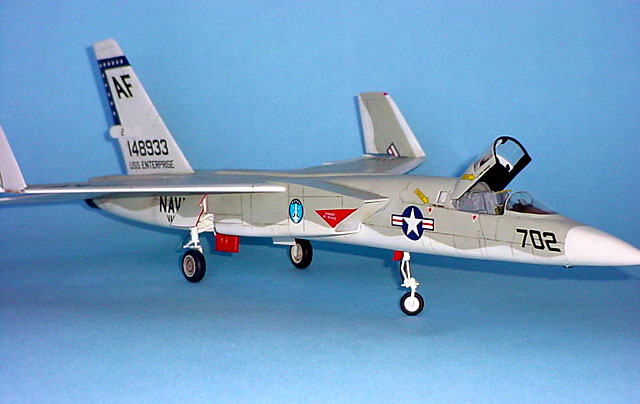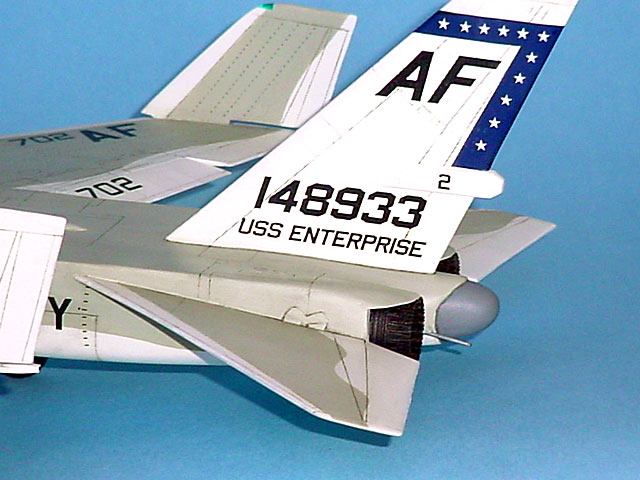|
North American
A-5A Vigilante
by
Darren Roberts
|

|
|
North American A-5A
Vigilante |

HyperScale is proudly supported by
Squadron.com
Developed during
the late 1950ís, North American Aviationís A3J Vigilante was designed to
fill the Navyís requirement for a high-speed nuclear bomber, replacing
the A3D Skywarrior in the heavy attack role. The resulting design was a
tandem-seated, sleek-looking aircraft with cutting-edge technology, such
as a linear bomb bay and one of the first operational HUDís. The
Vigilante reached fleet squadrons in 1962, deploying aboard the USS
Enterprise with VAH-7 Peacemakers. The next squadron to receive the A3J
was VAH-1 Smokiní Tigers.

Soon after entering
fleet service, Secretary of Defense Robert McNamara instituted his idea
of commonality, a part of which including changing aircraft designations
to the Air Force style. The A3J became the A-5A. However, A-5Aís were
not to be seen in service for very long. Problems with the linear bomb
bay were never satisfactorily solved, and it soon became apparent that
the mission for which the Vigilante was designed couldnít be fulfilled.
NAA, sensing that this was the case, began an upgrade to the original
design, adding fuel cells in the fuselage and integrating a
reconnaissance ďcanoeĒ under the belly of the aircraft. The Navy bought
into the idea, and the RA-5C, which would equip squadrons for more than
a decade, was born.
Only 2 fleet
squadrons ever flew the A-5A in its original attack configuration,
although the RA-5C still kept that ability. It also made only 3 cruises
on board a carrier. Most of the A-5Aís in service were returned to NAA
to be converted into RA-5Cís, while a few others were used for
high-speed testing. While not deemed a success as an attack aircraft,
the Vigilante never the less was jump forward in aircraft design, and
found its true calling as a recon platform.
For years, modelers
have wanted a 1/48 Vigilante, myself included.
The idea for this
project occurred about 5 years ago when I browsing through a hobby shop
and looked inside the box of a 1/72 ESCI Tu-22 Backfire bomber. It
struck me that the lines of that aircraft were very similar to the
A-5ís, including the placement of the rear window. I figured that no
manufacturer would produce a Vigilante in the near future, so I decided
to give it a try. I chose the A-5A version because I figured that if
someone DID actually come out with a model, it would be the RA-5C
version.
Scratchbuilding a 1/48 Scale A-5
To make a long
story short, I cobbled together parts from various models to
scratchbuild my A-5.
The entire front
fuselage section and lower rear fuselage half is from the 1/72 ESCI
Tu-22.
The wings come from
a 1/48 Mig-25, while the folded sections are the outer wings from a 1/72
Mig-25. The windscreen is the rear portion of a 1/48 F-15 canopy, while
the canopy comes from modifying an A-7 canopy.

The intakes are
modified F-14 intakes, the linear bomb bay cap is the nose to an F4D
Skyray, the horizontal and vertical stabs are thick sheet styrene sanded
to shape, the main wheel wells are from an F-8 Crusader, and the nozzles
are from Aires.
As for the landing
gear, the front gear is a combination of A-4 and F7F gear with two outer
halves of F-8 Crusader main wheels for the A-5ís front wheel. The main
gear are modified F-14 and F-4 gear with F-4 wheel hubs placed into F-14
tires.
The cockpit began
life as an F-4 cockpit, but was heavily modified to at least get close
to the A-5ís. Originally, I stuck a Martin Baker Mk. 7 seat in, but
decided to scratchbuild a seat that more closely resembled the
Vigilanteís unique seat.
Reconditioning the Vigilante
I had originally
finished this project about 5 years ago in VAH-1 markings, but was never
completely satisfied with the finished product. Over the years, my
skills improved and I discovered better materials, such as Tamiya putty
and Milliput. So, I decided to give it another go.
I completely broke
it apart, stripped as much paint and putty off as I could, and started
over. This was both a blessing and a curse. It allowed me rescribe the
panel lines in greater detail, but remnants of the old putty kept
chipping off, making it difficult to get nice crisp lines scribed onto
the surface. I did as much fixing as I could bear, but there are still
some ďsoftĒ areas where the putty chipped away.
The area that
almost drove me to the nut house was the wing rivets. I drilled more
than 800 on the surface of both wings. I donít think I want to look at
another pin vice for a very long time! In the end, though, it was worth
the effort, because it looks much more realistic now than when I first
finished it.
I primed the entire
model with Mr. Surfacer 1000, then sprayed Boydís White Primer for the
white areas.
The Gull Gray was
Model Master Acryl. For the decals, I was able to get my hands on a set
of Collect-Air RA-5C decals (thanks Rene) which provided me with the
stenciling and unit markings.
For the markings on
the tail, I received a scanned image of Superscaleís old 1/72 sheet,
which I used to make my own decals on a copier.

For the life of me
I canít remember the name of the great guy who sent it to me, and the
email was deleted, so whoever you are, thanks a bunch, and feel free to
identify yourself!
I donít think this
will ever win any awards, but this was by far the most rewarding
modeling project Iíve ever done. At the very least, I have a 1/48
Vigilante in my collection. Now, on to the rest of CVW-6 aircraft!
Click on the thumbnails
below to view larger images:
Images and Text Copyright © 2003 by
Darren Roberts
Page Created 25 May, 2003
Last Updated 25 March, 2004
Back to HyperScale
Main Page
|
Home |
What's New |
Features |
Gallery |
Reviews |
Reference |
Forum |
Search